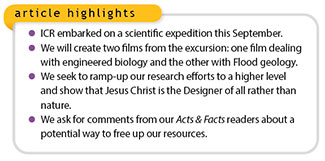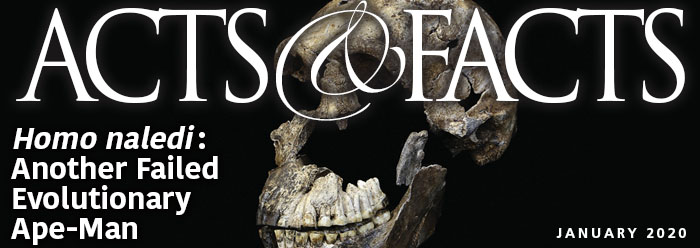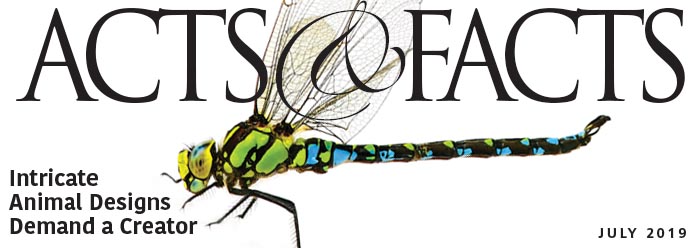 If all is on schedule, and with the good blessings of the Lord Jesus, then as you read this article nearly all of the ICR scientists and a number of support staff will be working on the first-ever ICR science expedition. This important research trip into northern Wyoming has multiple scientific objectives. Objectives were carefully selected to be “big picture and big impact” to advance creation science. The overriding goal of this arduous excursion is to enhance the power of our scientific models to explain natural phenomena that are both informed by Scripture and scientifically sound but also expressed in ways that reach the average person.
If all is on schedule, and with the good blessings of the Lord Jesus, then as you read this article nearly all of the ICR scientists and a number of support staff will be working on the first-ever ICR science expedition. This important research trip into northern Wyoming has multiple scientific objectives. Objectives were carefully selected to be “big picture and big impact” to advance creation science. The overriding goal of this arduous excursion is to enhance the power of our scientific models to explain natural phenomena that are both informed by Scripture and scientifically sound but also expressed in ways that reach the average person.
A main priority is to film ICR scientists in at least 15 locations to produce two educational films. One film will introduce an explanation of biological adaptation that fully breaks away from Darwinian selectionism—a destructive worldview that is poisoning science. Our new engineering-based model called continuous environmental tracking (CET) emphasizes the incredible problem-solving abilities Christ designed into creatures. The second film will underscore the vital importance that Dr. Tim Clarey’s worldwide bore-hole research provides to Flood geology.
The Lord Jesus said that He would build such a powerful church that against it even the gates of hell could not prevail (Matthew 16:18). That sounds like a pretty intense battle, and ICR—especially because of our research—is in the thick of it. I would like to explain why ICR will be increasing our commitment to original research in creation science.
Not Glamorous but Imperative
We’ve all heard the phrase “If I had a dollar for every time I heard…I’d be rich.” Since becoming president of ICR I have heard multiple times something along the lines of “Nobody, absolutely nobody is excited about ‘research!’ Booor-ring! If you really want to get Christians’ attention, grow the ICR ‘brand,’ or attract donations, then you must focus the power of ICR on things like LGBTQ+ inroads, global warming, and the other ‘hot button’ topics. These will fire up your base. If you don’t, other ministries will jump at the chance.” If the dollar rule applied to this issue, I would be wealthy. We at ICR certainly care about the evil fruits rapidly making inroads in society. The fruit grows from a worldview militantly opposed to Christ. This worldview is not fundamentally atheistic but idolatrous. So, the fruit is not the root problem.
Romans 1:25 identifies the root. Here, Paul says that the true Creator God is exchanged for a lie (literally, in context, “the false” god).1 The “false god” is identified as nature itself as people worship and serve (as in religious devotion) the creation more than its true Creator. How telling.
Today’s science-focused culture worships nature as the giver of life and the cause of all of its diversity—perhaps more so than at any time in history. It may not be a stretch to say that many people today idolize nature. Darwin’s nature-centric approach to biology has immense backing in the scientific community. Why does it have so much appeal? Many scientists and philosophers believe that Darwin cracked the nut on how to explain the obvious design of creatures without appealing to a Designer—that nature itself is the Designer and exercises intelligent agency over creatures.2 This is where ICR research and theory development play a crucial role pushing back against Darwinian selectionism.
First, Darwin focused his ideas on a creature’s ability to change. He devised an anti-designer way to interpret adaptability by portraying it the exact opposite way of what a real engineer would do. In other words, for Darwin adaptable changes are hit and miss, non-purposeful, and extremely gradual.
However, ICR has some better ideas. Our CET model reinterprets a mountain of other data and is finding that adaptation can often be characterized as highly regulated, rapid, usually repeatable, sometimes reversible, and with targeted solutions that are even predictable. This research demonstrates that the way creatures’ innate systems enable them to self-adjust to environmental challenges is similar to how an engineer would design them. Some original ICR research is in the process of being published, and it strongly supports the CET model.
Second, Darwin made it easy for scientists who publish in technical journals to talk about nature as if it could exercise creative agency.3 Darwin introduced an overt mysticism into science via selectionism. He personifies nature by projecting onto it “selective” abilities akin to how human breeders with real minds select for traits in creatures. Projecting selective ability onto nature inherently projects volition and intelligence onto it as well. Thus, in people’s minds they imaginatively see nature exercising God-like actions such as “selecting,” “favoring,” “punishing,” or “acting on” organisms. New theoretical frameworks developed by ICR have exposed this deification of nature inherent to Darwin’s selectionist worldview as the secular sacred imposter for the true Creator God as in Romans 1:25.4 There is no doubt that ICR research is needed today as much as it has ever been.
A New Focus on Research
With the importance of research in mind, ICR would like to spend more time focusing on it. Let me give some of the backstory. This will allow you to put your thoughts together that I am asking you to share with us.
Some of our readers might recall that Acts & Facts used to be a folded half-page newsletter sent out monthly for decades. (I still have nearly all of them saved by year in my bookcase.) Then we greatly increased the number of features with our new magazine style of Acts & Facts in its current form. Many readers have expressed how appreciative they are for the materials in the magazine.
However, what we realized is that hand-in-hand with producing a full-blown magazine is a huge increase in time demanded from our scientists and editors. That fact probably explains why magazine production is the sole full-time job of some companies. In fact, producing our magazine now consumes nearly three weeks of the month for our Communications and Science departments. Obviously, this leaves only one week per month to work on book and video production and—most importantly—research…before the cycle repeats. Yet, our readers and everyone at ICR love our current Acts & Facts notwithstanding the large man-hours needed to produce it.
I speak to hundreds of our readers and supporters “out in the field” during the many events that we conduct. A number who’ve faithfully followed ICR have noticed a decrease in our book production and original research. After I explain why simply building up our staff is more complicated than at first thought (especially for adding research scientists who need multiple talents), they offer recommendations on how we can find more time for research.
The solution offered most frequently is to keep the current popular format for Acts & Facts but just reduce the number of issues to eight, nine, or ten per year. The issues least likely to be read due to vacation or pressing work needs are mid-summer and shortly after the New Year. If this suggestion was implemented, then it would free up several full months to reallocate our manpower exclusively to new research and fresh resource development.
These changes will allow our research team to have more time to do higher-quality, uninterrupted research—especially in biology. As described last November,5 ICR is actively developing a new engineering-based model that could change the fundamental explanation of how biological functions operate…away from simply a lighter version of Darwinism and to one that fully honors Christ as Creator.
So, that is our problem and a possible solution. Some folks have suggested that if we decreased Acts & Facts by a few issues then support for our research would actually decrease. I’m less than persuaded of that reaction, particularly if we are transparent in explaining a reason to our supporters that makes sense.
Yet, since this is a big change that would affect well over 100,000 readers at this time, I am asking for your thoughts—pro or con—on this recommendation. Many readers may likely be neutral, but if you have any thoughts of encouragement or concern that you would like to share, please write us at contact@icr.org or ICR, attn: Bruce Wood, 1806 Royal Lane, Dallas, TX 75229. Thank you very much for your love and faithfulness to ICR for so many years. The continued blessings of the Lord Jesus to you.
References
- Guliuzza, R. J. 2017. Engineered Adaptability: Engineering Principles Point to God’s Workmanship. Acts & Facts. 46 (6): 16-19.
- Ayala, F. J. 2007. Darwin’s Greatest Discovery: Design without Designer. Proceedings of the National Academy of Sciences. 104: 8567-8573.
- Lewontin, R. C. 2010. Not So Natural Selection. The New York Review of Books.
- Guliuzza, R. J. 2011. Darwin’s Sacred Imposter: Natural Selection’s Idolatrous Trap. Acts & Facts. 40 (11): 12-15.
- Guliuzza, R. J. 2020. The Power of the Next Idea. Acts & Facts. 49 (11): 4-6.
* Dr. Guliuzza is President of the Institute for Creation Research. He earned his M.D. from the University of Minnesota, his Master of Public Health from Harvard University, and served in the U.S. Air Force as 28th Bomb Wing Flight Surgeon and Chief of Aerospace Medicine. Dr. Guliuzza is also a registered Professional Engineer and holds a B.A. in theology from Moody Bible Institute.

















